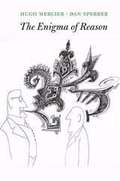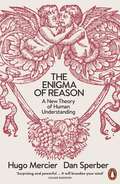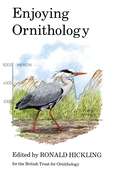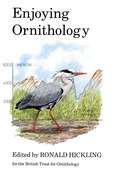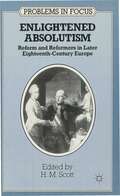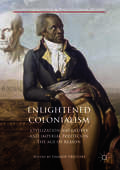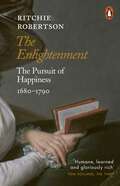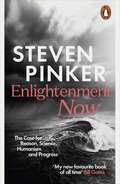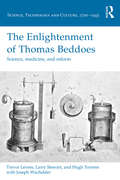- Table View
- List View
The Enigma of Reason
by Hugo MercierIf reason is so useful and reliable, why didn’t it evolve in other animals and why do humans produce so much thoroughly reasoned nonsense? Hugo Mercier and Dan Sperber argue that reason is not geared to solitary use. It evolved to help justify our beliefs to others, evaluate their arguments, and better exploit our uniquely rich social environment.
The Enigma of Reason: A New Theory of Human Understanding
by Dan Sperber Hugo MercierGUARDIAN BOOKS OF THE YEAR 2017'Original and provocative ... likely to have a big impact on our understanding of ourselves' Steven Pinker'Mercier and Sperber offer a surprising and powerful response to the new orthodoxy propounded by Kahneman and Tversky ... arguing that the supposed flaws of hot, fast, automatic thinking are actually design features which work remarkably well' Julian BagginiReason, we are told, is what makes us human, the source of our knowledge and wisdom. But, if reason is so useful, why didn't it also evolve in other animals? If it is that reliable, why do we produce so much thoroughly reasoned nonsense?In their ground-breaking account of the evolution and workings of reason, Hugo Mercier and Dan Sperber set out to solve this double enigma, taking us on a journey from desert ants to modern scientists, and from Aristotle to Daniel Kahneman. Reason, they argue with a compelling mix of real-life and experimental evidence, is not geared to solitary use, to arriving at better beliefs and decisions on our own. What reason does, rather, is help us justify our beliefs and actions to others, convince them through argumentation, and evaluate the justifications and arguments that they address to us.In other words, reason has evolved to help humans better exploit their uniquely rich social environment. This illuminating interpretation of reason makes sense of strengths and weaknesses that have long puzzled philosophers and psychologists - why reason is biased in favour of what we already believe, why it may lead to terrible ideas and yet is indispensable to spreading good ones. Ambitious, provocative, and entertaining, The Enigma of Reason will spark debate among psychologists and philosophers, and make many reasonable people rethink their own thinking.
The Enigma of the Aerofoil: Rival Theories in Aerodynamics, 1909-1930
by David BloorWhy do aircraft fly? How do their wings support them? In the early years of aviation, there was an intense dispute between British and German experts over the question of why and how an aircraft wing provides lift. The British, under the leadership of the great Cambridge mathematical physicist Lord Rayleigh, produced highly elaborate investigations of the nature of discontinuous flow, while the Germans, following Ludwig Prandtl in Göttingen, relied on the tradition called “technical mechanics” to explain the flow of air around a wing. Much of the basis of modern aerodynamics emerged from this remarkable episode, yet it has never been subject to a detailed historical and sociological analysis. In The Enigma of the Aerofoil, David Bloor probes a neglected aspect of this important period in the history of aviation. Bloor draws upon papers by the participants—their restricted technical reports, meeting minutes, and personal correspondence, much of which has never before been published—and reveals the impact that the divergent mathematical traditions of Cambridge and Göttingen had on this great debate. Bloor also addresses why the British, even after discovering the failings of their own theory, remained resistant to the German circulation theory for more than a decade. The result is essential reading for anyone studying the history, philosophy, or sociology of science or technology—and for all those intrigued by flight.
The Enigma of the Aerofoil: Rival Theories in Aerodynamics, 1909-1930
by David BloorWhy do aircraft fly? How do their wings support them? In the early years of aviation, there was an intense dispute between British and German experts over the question of why and how an aircraft wing provides lift. The British, under the leadership of the great Cambridge mathematical physicist Lord Rayleigh, produced highly elaborate investigations of the nature of discontinuous flow, while the Germans, following Ludwig Prandtl in Göttingen, relied on the tradition called “technical mechanics” to explain the flow of air around a wing. Much of the basis of modern aerodynamics emerged from this remarkable episode, yet it has never been subject to a detailed historical and sociological analysis. In The Enigma of the Aerofoil, David Bloor probes a neglected aspect of this important period in the history of aviation. Bloor draws upon papers by the participants—their restricted technical reports, meeting minutes, and personal correspondence, much of which has never before been published—and reveals the impact that the divergent mathematical traditions of Cambridge and Göttingen had on this great debate. Bloor also addresses why the British, even after discovering the failings of their own theory, remained resistant to the German circulation theory for more than a decade. The result is essential reading for anyone studying the history, philosophy, or sociology of science or technology—and for all those intrigued by flight.
The Enigma of the Aerofoil: Rival Theories in Aerodynamics, 1909-1930
by David BloorWhy do aircraft fly? How do their wings support them? In the early years of aviation, there was an intense dispute between British and German experts over the question of why and how an aircraft wing provides lift. The British, under the leadership of the great Cambridge mathematical physicist Lord Rayleigh, produced highly elaborate investigations of the nature of discontinuous flow, while the Germans, following Ludwig Prandtl in Göttingen, relied on the tradition called “technical mechanics” to explain the flow of air around a wing. Much of the basis of modern aerodynamics emerged from this remarkable episode, yet it has never been subject to a detailed historical and sociological analysis. In The Enigma of the Aerofoil, David Bloor probes a neglected aspect of this important period in the history of aviation. Bloor draws upon papers by the participants—their restricted technical reports, meeting minutes, and personal correspondence, much of which has never before been published—and reveals the impact that the divergent mathematical traditions of Cambridge and Göttingen had on this great debate. Bloor also addresses why the British, even after discovering the failings of their own theory, remained resistant to the German circulation theory for more than a decade. The result is essential reading for anyone studying the history, philosophy, or sociology of science or technology—and for all those intrigued by flight.
The Enigma of the Aerofoil: Rival Theories in Aerodynamics, 1909-1930
by David BloorWhy do aircraft fly? How do their wings support them? In the early years of aviation, there was an intense dispute between British and German experts over the question of why and how an aircraft wing provides lift. The British, under the leadership of the great Cambridge mathematical physicist Lord Rayleigh, produced highly elaborate investigations of the nature of discontinuous flow, while the Germans, following Ludwig Prandtl in Göttingen, relied on the tradition called “technical mechanics” to explain the flow of air around a wing. Much of the basis of modern aerodynamics emerged from this remarkable episode, yet it has never been subject to a detailed historical and sociological analysis. In The Enigma of the Aerofoil, David Bloor probes a neglected aspect of this important period in the history of aviation. Bloor draws upon papers by the participants—their restricted technical reports, meeting minutes, and personal correspondence, much of which has never before been published—and reveals the impact that the divergent mathematical traditions of Cambridge and Göttingen had on this great debate. Bloor also addresses why the British, even after discovering the failings of their own theory, remained resistant to the German circulation theory for more than a decade. The result is essential reading for anyone studying the history, philosophy, or sociology of science or technology—and for all those intrigued by flight.
The Enigma of the Aerofoil: Rival Theories in Aerodynamics, 1909-1930
by David BloorWhy do aircraft fly? How do their wings support them? In the early years of aviation, there was an intense dispute between British and German experts over the question of why and how an aircraft wing provides lift. The British, under the leadership of the great Cambridge mathematical physicist Lord Rayleigh, produced highly elaborate investigations of the nature of discontinuous flow, while the Germans, following Ludwig Prandtl in Göttingen, relied on the tradition called “technical mechanics” to explain the flow of air around a wing. Much of the basis of modern aerodynamics emerged from this remarkable episode, yet it has never been subject to a detailed historical and sociological analysis. In The Enigma of the Aerofoil, David Bloor probes a neglected aspect of this important period in the history of aviation. Bloor draws upon papers by the participants—their restricted technical reports, meeting minutes, and personal correspondence, much of which has never before been published—and reveals the impact that the divergent mathematical traditions of Cambridge and Göttingen had on this great debate. Bloor also addresses why the British, even after discovering the failings of their own theory, remained resistant to the German circulation theory for more than a decade. The result is essential reading for anyone studying the history, philosophy, or sociology of science or technology—and for all those intrigued by flight.
The Enigma of the Aerofoil: Rival Theories in Aerodynamics, 1909-1930
by David BloorWhy do aircraft fly? How do their wings support them? In the early years of aviation, there was an intense dispute between British and German experts over the question of why and how an aircraft wing provides lift. The British, under the leadership of the great Cambridge mathematical physicist Lord Rayleigh, produced highly elaborate investigations of the nature of discontinuous flow, while the Germans, following Ludwig Prandtl in Göttingen, relied on the tradition called “technical mechanics” to explain the flow of air around a wing. Much of the basis of modern aerodynamics emerged from this remarkable episode, yet it has never been subject to a detailed historical and sociological analysis. In The Enigma of the Aerofoil, David Bloor probes a neglected aspect of this important period in the history of aviation. Bloor draws upon papers by the participants—their restricted technical reports, meeting minutes, and personal correspondence, much of which has never before been published—and reveals the impact that the divergent mathematical traditions of Cambridge and Göttingen had on this great debate. Bloor also addresses why the British, even after discovering the failings of their own theory, remained resistant to the German circulation theory for more than a decade. The result is essential reading for anyone studying the history, philosophy, or sociology of science or technology—and for all those intrigued by flight.
Enigmatic Microorganisms and Life in Extreme Environments (Cellular Origin, Life in Extreme Habitats and Astrobiology #1)
by Joseph SeckbachModern methods and approaches, such as the analysis of molecular sequences to infer evolutionary relationships among organisms, have provided vast new sets of data to further our understanding ofliving organisms, but there remain enigmas in the biological world that will keep scientists working and thinking for decades. Microorganisms by virtue of their small size and almost unbounded diversity provide ample examples of intriguing mysteries that are being challenged with all of the techniques the modern scientific arsenal can provide. One whole arena of this battle to resolve puzzling mysteries about various microorganisms is the almost unbelievable ability of many micro-organisms to live in extreme environments. Whether the challenge is extreme heat, cold, pressure, hyper salinity, alkalinity or acidity, some micro-organisms live now where no life might seem possible. This fascinating state of affairs is the context for this present volume edited by Joseph Seckbach. This Volume is a compilation of many of the especially interesting questions and biological challenges that arise in the consideration of microorganisms in general and the extremophiles in particular.
Enjoy Our Universe: You Have No Other Choice
by Alvaro De RújulaEnjoy Our Universe is a guide for an enjoyable visit to the Universe. The "Universe" refers to all "observable things," ranging in size from the entire cosmos to elementary particles. This small tome on fundamental physics, cosmology, Higgs bosons, time travel and all that, is unlike any other analogous book. Its scientific statements are correct or, at least, they coincide with the opinions held by the vast majority of experts. It establishes clear distinctions between things we know for sure — in the sense of having strong observational support for them — and things that we know that we do not know, or we do not understand. In this sense, it is scientifically honest. In descriptions of our Universe and of the way it functions, beauty is a recurring word. In an attempt to portray its beauty from the eyes of the beholder, the book is profusely illustrated. Its offbeat, tongue-in-cheek illustrations greatly enhance its readability, particularly in those chapters whose understanding, admittedly, requires a little extra effort. This book's idiosyncracies remind us of our own smallness and eccentricities even as we read about the logic, function and magnificence of the Universe.
Enjoy Our Universe: You Have No Other Choice
by Alvaro De RújulaEnjoy Our Universe is a guide for an enjoyable visit to the Universe. The "Universe" refers to all "observable things," ranging in size from the entire cosmos to elementary particles. This small tome on fundamental physics, cosmology, Higgs bosons, time travel and all that, is unlike any other analogous book. Its scientific statements are correct or, at least, they coincide with the opinions held by the vast majority of experts. It establishes clear distinctions between things we know for sure — in the sense of having strong observational support for them — and things that we know that we do not know, or we do not understand. In this sense, it is scientifically honest. In descriptions of our Universe and of the way it functions, beauty is a recurring word. In an attempt to portray its beauty from the eyes of the beholder, the book is profusely illustrated. Its offbeat, tongue-in-cheek illustrations greatly enhance its readability, particularly in those chapters whose understanding, admittedly, requires a little extra effort. This book's idiosyncracies remind us of our own smallness and eccentricities even as we read about the logic, function and magnificence of the Universe.
Enjoying Ornithology (Poyser Monographs)
by Ronald HicklingThis year, 1983, the British Trust for Ornithology celebrates its first 50 years and this volume records much of the history of birdwatching and ornithology since the early 1930s. The book is not a history of the BTO, but many of the Trust's achievements helped fashion the development and direction of ornithology over the decades, and major aspects of the Trust's work rightly have detailed treatment. The book ranges widely, it looks at the changing bird as well as the changing bird watcher and records the work of related conservation bodies, it considers the future and the past and includes an extensive section of useful facts and figures, whilst never losing sight of the central theme which is the book's title.
Enjoying Ornithology (Poyser Monographs #109)
by Ronald HicklingThis year, 1983, the British Trust for Ornithology celebrates its first 50 years and this volume records much of the history of birdwatching and ornithology since the early 1930s. The book is not a history of the BTO, but many of the Trust's achievements helped fashion the development and direction of ornithology over the decades, and major aspects of the Trust's work rightly have detailed treatment. The book ranges widely, it looks at the changing bird as well as the changing bird watcher and records the work of related conservation bodies, it considers the future and the past and includes an extensive section of useful facts and figures, whilst never losing sight of the central theme which is the book's title.
Enlightened Absolutism: Reform and Reformers in Later Eighteenth-Century Europe (Problems in Focus)
Each book in this series is designed to make available to students important new work on key historical problems and periods that they encounter. Each volume, devoted to a central topic or theme, contains specially comisssioned essays from scholars in the relevant field. These provide an assessment of a particular aspect, pointing out areas of development and controversy and indicating where conclusions can be drawn or where further work is necessary, while an editorial introduction reviews the problem or period as a whole. In this text the contributors assess reform and reformers in late 18th century Europe, covering such topics as Catherine the Great, the Danish reformers, the Habsburg Monarchy and events in Spain and Italy.
Enlightened Colonialism: Civilization Narratives and Imperial Politics in the Age of Reason
by Damien TricoireThis book further qualifies the postcolonial thesis and shows its limits. To reach these goals, it links text analysis and political history on a global comparative scale. Focusing on imperial agents, their narratives of progress, and their political aims and strategies, it asks whether Enlightenment gave birth to a new colonialism between 1760 and 1820. Has Enlightenment provided the cultural and intellectual origins of modern colonialism? For decades, historians of political thought, philosophy, and literature have debated this question. On one side, many postcolonial authors believe that enlightened rationalism helped delegitimize non-European cultures. On the other side, some historians of ideas and literature are willing to defend at least some eighteenth-century philosophers whom they consider to have been “anti-colonialists”. Surprisingly enough, both sides have focused on literary and philosophical texts, but have rarely taken political and social practice into account.
Enlightened Colonialism: Civilization Narratives and Imperial Politics in the Age of Reaso (PDF)
by Damien TricoireThis book further qualifies the postcolonial thesis and shows its limits. To reach these goals, it links text analysis and political history on a global comparative scale. Focusing on imperial agents, their narratives of progress, and their political aims and strategies, it asks whether Enlightenment gave birth to a new colonialism between 1760 and 1820. Has Enlightenment provided the cultural and intellectual origins of modern colonialism? For decades, historians of political thought, philosophy, and literature have debated this question. On one side, many postcolonial authors believe that enlightened rationalism helped delegitimize non-European cultures. On the other side, some historians of ideas and literature are willing to defend at least some eighteenth-century philosophers whom they consider to have been “anti-colonialists”. Surprisingly enough, both sides have focused on literary and philosophical texts, but have rarely taken political and social practice into account.
The Enlightened Mr. Parkinson: The Pioneering Life of a Forgotten English Surgeon
by Cherry LewisParkinson’s disease is one of the most common forms of dementia, with 10,000 new cases each year in the UK alone, and yet few know anything about the man the disease is named after. In 1817 – exactly 200 years ago – James Parkinson (1755–1824) defined the disease so precisely that we still diagnose it today by recognising the symptoms he identified. The story of this remarkable man’s contributions to the Age of the Enlightenment is told through his three passions – medicine, politics and fossils. As a political radical Parkinson was interrogated over a plot to kill King George III and revealed as the author of anti-government pamphlets, a crime for which many were transported to Australia; while helping Edward Jenner set up smallpox vaccination stations across London, he wrote the first scientific study of fossils in English, which led to fossil-hunting becoming the nation’s latest craze – just a glimpse of his many achievements. Cherry Lewis restores this neglected pioneer to his rightful place in history, while creating a vivid and pungent portrait of life as an ‘apothecary surgeon’ in Georgian London.
The Enlightenment (Studies in European History)
by Roy PorterThe eighteenth-century Enlightenment was one of the most exciting and significant currents of European culture. Battling against tyranny, ignorance and superstition, it formulated the ideals which still inform our society today: a belief in reason, criticism, freedom of thought, religion and expression, the value of science, the pursuit of progress. Enlightenment thinkers undermined the ancien regime and provided the ideas for the French Revolution. Modern scholarship, however, has shown it was a more complex and ambiguous movement than commonly recognized. This book, now in a fully updated second edition, sympathetically explores the complexities of the Enlightenment. Synthesizing and evaluating the latest scholarship, it offers a new and comprehensive vision of this many-faceted movement.
The Enlightenment: The Pursuit of Happiness 1680-1790 (Oxford University Studies In The Enlightenment Ser. #2013:09)
by Ritchie RobertsonThe Enlightenment is one of the formative periods of Western history, yet more than 300 years after it began, it remains controversial. It is often seen as the fountainhead of modern values such as human rights, religious toleration, freedom of thought, scientific thought as an exemplary form of reasoning, and rationality and evidence-based argument. Others accuse the Enlightenment of putting forward a scientific rationality which ignores the complexity and variety of human beings, propagates shallow atheism, and aims to subjugate nature to so-called technical progress. Answering the question 'what is Enlightenment?' Kant famously urged men and women above all to 'have the courage to use your own understanding'. Robertson shows how the thinkers of the Enlightenment did just that, seeking a rounded understanding of humanity in which reason was balanced with emotion and sensibility. His book goes behind the controversies about the Enlightenment to return to its original texts and to show that above all it sought to increase human happiness in this world by promoting scientific inquiry and reasoned argument. His book overturns many received opinions - for example, that enlightenment necessarily implied hostility to religion (though it did challenge the authority traditionally assumed by the Churches). It is a master-class in 'big picture' history, about one of the foundational epochs of modern times.
Enlightenment and Modernity
by Robert WoklerThis collection of essays is addressed to the legacy of Enlightenment thought, with respect to eighteenth-century notions of human nature, human rights, representative democracy or the nation-state, and with regard to the barbarism, including the Holocaust, allegedly unleashed by eighteenth-century ideals of civilization.
Enlightenment Geography: The Political Languages of British Geography, 1650-1850 (Studies in Modern History)
by R. MayhewEnlightenment Geography is the first detailed study of the politics of British geography books and of related forms of geographical knowledge in the period from 1650 to 1850. The definition and role of geography in a humanist structure of knowledge are examined and shown to tie it to political discourse. Geographical works are shown to have developed Whig and Tory defences of the English church and state, consonant with the conservatism of the English Enlightenment. These politicizations were questioned by those indebted to the Scottish Enlightenment. Enlightenment Geography questions broad assumptions about British intellectual history through a revisionist history of geography.
Enlightenment, Modernity and Science: Geographies of Scientific Culture and Improvement in Georgian England (Tauris Historical Geographical Series)
by Paul A. ElliotScientific culture was one of the defining characteristics of the English Enlightenment, permeating many aspects of Georgian society and culture. As new and mysterious realms were opened up, intellectual orthodoxies challenged, and exotic specimens acquired for aristocratic estates, private collections and museums, so the latest discoveries in astronomy, electricity and natural history were discussed and debated in homes, institutions, towns and cities around the country. But how did the production and dissemination of scientific knowledge vary with geographical location? What were the differing influences in town and country and from region to region? Enlightenment, Modernity and Science provides the first full length study of the geographies of Georgian scientific culture in England. Drawing on a wide range of sources, including manuscripts, institutional records, personal memoirs and correspondence, the author takes the reader on a tour of the principal arenas in which scientific ideas were disseminated and discussed - including the home, town and countryside - to show how the cultures of science and knowledge varied across the Georgian landscape. The importance of the Georgian domestic environment is explored and metropolitan scientific culture is contrasted with county towns such as York, Norwich and Hull, showing how aristocratic, gentlemanly and professional status nurtured relatively autonomous cultures. The role of natural philosophy in the formation of new spaces for science - such as public botanical gardens - is revealed and it is shown how this influenced, and was in turn influenced by, different sections of society. Taking in key figures such as Erasmus Darwin, Abraham Bennett, and Joseph Priestley along the way, and with chapters on science and the dissenting academies, and Freemasonry and antiquarianism, Enlightenment, Modernity and Science is a work that sheds important light on the complex geographies of Georgian English scientific culture.
Enlightenment Now: The Case for Reason, Science, Humanism, and Progress
by Steven Pinker'My new favourite book of all time' Bill GatesTOP TEN SUNDAY TIMES BESTSELLERIs modernity really failing? Or have we failed to appreciate progress and the ideals that make it possible?If you follow the headlines, the world in the 21st century appears to be sinking into chaos, hatred, and irrationality. Yet Steven Pinker shows that this is an illusion - a symptom of historical amnesia and statistical fallacies. If you follow the trendlines rather than the headlines, you discover that our lives have become longer, healthier, safer, happier, more peaceful, more stimulating and more prosperous - not just in the West, but worldwide. Such progress is no accident: it's the gift of a coherent and inspiring value system that many of us embrace without even realizing it. These are the values of the Enlightenment: of reason, science, humanism and progress.The challenges we face today are formidable, including inequality, climate change, Artificial Intelligence and nuclear weapons. But the way to deal with them is not to sink into despair or try to lurch back to a mythical idyllic past; it's to treat them as problems we can solve, as we have solved other problems in the past. In making the case for an Enlightenment newly recharged for the 21st century, Pinker shows how we can use our faculties of reason and sympathy to solve the problems that inevitably come with being products of evolution in an indifferent universe. We will never have a perfect world, but - defying the chorus of fatalism and reaction - we can continue to make it a better one.
The Enlightenment of Thomas Beddoes: Science, medicine, and reform (Science, Technology and Culture, 1700-1945)
by Trevor Levere Larry Stewart Hugh Torrens Joseph WachelderThomas Beddoes (1760-1808) lived in ‘decidedly interesting times’ in which established orders in politics and science were challenged by revolutionary new ideas. Enthusiastically participating in the heady atmosphere of Enlightenment debate, Beddoes' career suffered from his radical views on politics and science. Denied a professorship at Oxford, he set up a medical practice in Bristol in 1793. Six years later - with support from a range of leading industrialists and scientists including the Wedgwoods, Erasmus Darwin, James Watt, James Keir and others associated with the Lunar Society - he established a Pneumatic Institution for investigating the therapeutic effects of breathing different kinds of ‘air’ on a wide spectrum of diseases. The treatment of the poor, gratis, was an important part of the Pneumatic Institution and Beddoes, who had long concerned himself with their moral and material well-being, published numerous pamphlets and small books about their education, wretched material circumstances, proper nutrition, and the importance of affordable medical facilities. Beddoes’ democratic political concerns reinforced his belief that chemistry and medicine should co-operate to ameliorate the conditions of the poor. But those concerns also polarized the medical profession and the wider community of academic chemists and physicians, many of whom became mistrustful of Beddoes’ projects due to his radical politics. Highlighting the breadth of Beddoes’ concerns in politics, chemistry, medicine, geology, and education (including the use of toys and models), this book reveals how his reforming and radical zeal were exemplified in every aspect of his public and professional life, and made for a remarkably coherent program of change. He was frequently a contrarian, but not without cause, as becomes apparent once he is viewed in the round, as part of the response to the politics and social pressures of the late Enlightenment.
The Enlightenment of Thomas Beddoes: Science, medicine, and reform (Science, Technology and Culture, 1700-1945)
by Trevor Levere Larry Stewart Hugh Torrens Joseph WachelderThomas Beddoes (1760-1808) lived in ‘decidedly interesting times’ in which established orders in politics and science were challenged by revolutionary new ideas. Enthusiastically participating in the heady atmosphere of Enlightenment debate, Beddoes' career suffered from his radical views on politics and science. Denied a professorship at Oxford, he set up a medical practice in Bristol in 1793. Six years later - with support from a range of leading industrialists and scientists including the Wedgwoods, Erasmus Darwin, James Watt, James Keir and others associated with the Lunar Society - he established a Pneumatic Institution for investigating the therapeutic effects of breathing different kinds of ‘air’ on a wide spectrum of diseases. The treatment of the poor, gratis, was an important part of the Pneumatic Institution and Beddoes, who had long concerned himself with their moral and material well-being, published numerous pamphlets and small books about their education, wretched material circumstances, proper nutrition, and the importance of affordable medical facilities. Beddoes’ democratic political concerns reinforced his belief that chemistry and medicine should co-operate to ameliorate the conditions of the poor. But those concerns also polarized the medical profession and the wider community of academic chemists and physicians, many of whom became mistrustful of Beddoes’ projects due to his radical politics. Highlighting the breadth of Beddoes’ concerns in politics, chemistry, medicine, geology, and education (including the use of toys and models), this book reveals how his reforming and radical zeal were exemplified in every aspect of his public and professional life, and made for a remarkably coherent program of change. He was frequently a contrarian, but not without cause, as becomes apparent once he is viewed in the round, as part of the response to the politics and social pressures of the late Enlightenment.
